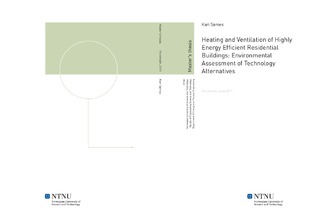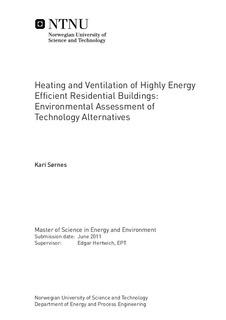| dc.description.abstract | The aim of this study was to determine the level of environmental impact and primary energy resulting from demands placed on residential ventilation and heating systems; a conventional residential house built to the 2007 Norwegian building code with a standard heating system was compared against three technology scenarios used in a passive house of the equivalent size. Both houses have wooden framework and cladding and are projected by the Norwegian building company Norbohus. An economical evaluation of the heating systems was also done. The alternative heating option for the conventional house, Stord TEK 07, was based on current Norwegian energy consumption patterns; a combination of electricity and firewood is used to meet heating demand. This heating mix was also modeled as an option for the heating requirements of the passive house, named Stord Passive S1. Additionally, a solar collector system (Stord Passive S2) and an air-to-water heat pump (Stord Passive S3) were modeled for the passive house. Finally, a balanced mechanical ventilation system was evaluated for both buildings. The life-cycle assessment method used was the ReCiPe method and the electricity used in the operation phase was based on the Nordic electricity mix.The results of this study indicate that Stord TEK 07 has the largest emission output in relation to output of CO2-eq, presented in the impact category Climate change . From a life-cycle perspective, the heating system requirements of a Stord TEK 07 house are 47.5 and 45 percent higher than the renewable energy solutions of passive house scenarios S2 and S3, respectively. Total life-cycle primary energy requirements in the Stord TEK 07 house were almost twice that of the renewable solutions in the passive house. Using the Norwegian standard heating system of Stord TEK 07 in a passive house as was done in Stord Passive S1, also results in a large improvement; output of CO2-eq and use of primary energy was reduced by 34-35 percent. Stord TEK 07 has also the highest emission output in most of the other impact categories and the largest present value costs, when building constructing costs are excluded. The heat pump solution, Stord Passive S3, has the lowest impact in most categories; however, the solar collector system Stord Passive S2, had lower output of CO2-eq. Stord Passive S2 has also lower present value costs then the air-water heat pump Stord Passive S3.A balanced ventilation system with 80 percent heat recovery was studied for both the houses. The benefit of heat recovery is recognizable in all the impact categories considered. The energy consumption and potential harmful emissions resulting from the electrical energy used by fans during the life cycle far exceed the environmental impacts that result from manufacture and transportation of the ventilation unit. The study revealed that the heat-recovery system must have efficiency greater than 15 percent to achieve reduction concerning output of CO2-eq and use of primary energy for Stord TEK 07; this requirement increases to 42 percent in houses built to the passive house standard house, Stord Passive. | nb_NO |

